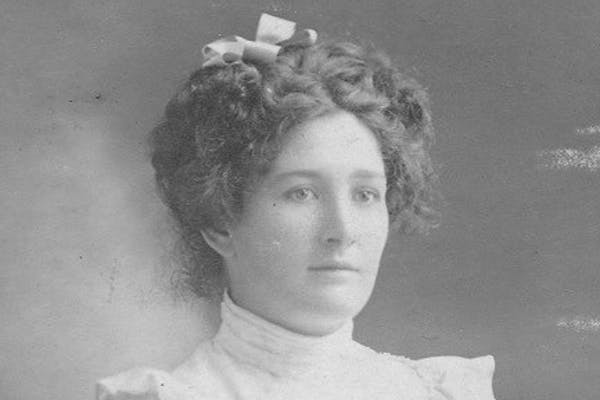Sisters Catherine and Rosina Lechler sailed together from Germany to America 175 years ago, marrying soon after arriving and settling on farms near Peoria, Ill.
A decade later, in 1857, Catherine, her husband Johan Kochendorfer and their four children (later five) struck out for St. Paul — seeking cheaper land and better opportunities in the Minnesota Territory.
"I feel so happy," Catherine wrote to her sister in German on Nov. 2, 1857, "… that although we are separated, we may, with pen, ink, and paper have heartfelt talks, which is especially very dear to me at this time."
Amazingly, that 165-year-old, faded-ink letter survives today. Catherine's 94-year-old great-granddaughter, Marilyn Hoffman, keeps it in a box in Hampton, Minn. — 25 miles south from where it was written. It's among a collection of letters and family records the family has painstakingly translated and preserved, including one to a friend in which Catherine wrote, "We never know how soon the call may come for us to leave this world."
The letters are especially poignant considering the Kochendorfers' grim fate. Five years after penning that letter to her sister, Catherine's family had taken advantage of the nation's 1862 Homestead Act — claiming 160 acres in Flora Township along the Minnesota River about 120 miles southwest of St. Paul. The land had long been home to the Dakota people, whose treaties with the U.S. government were unraveling during the Civil War.
Four months after moving near Redwood Falls, Minn., the Kochendorfers found themselves in the vortex of the five-week U.S.-Dakota War that erupted in 1862 along the Minnesota River. Starving and frustrated by late government payments, some militant Dakota decided to wage war to regain their land while most of Minnesota's able-bodied men were fighting far off in the Civil War.
Johan, Catherine and 3-year-old Sarah were killed the first morning of the war, while Johan Jr., 11; Rosina, 9; Katherine, 7; and Margaret, 5, escaped into the woods. They made their way along a creekside ravine before an oxcart of fleeing settlers helped them complete the 25-mile trek to Fort Ridgely.
"The force of events had thrown them all to the wind," Maplewood author Dan Munson wrote in his 2014 book, "Malice Toward None," which chronicles the Kochendorfers' clash with the bloody history of their times and tells the inspiring survival story of the four kids. (tinyurl.com/KochendorferBook)
A retired 3M Co. chemical engineer, Munson will discuss the Kochendorfers on Sunday afternoon at a most fitting venue. Back in 1858, when the Kochendorfers still lived in St. Paul, they were among the founders of what's now known as the Old Salem Shrine — a one-room church along Schmidt Lake at Upper 55th Street and Annette Avenue in Inver Grove Heights.
Although the last regular Methodist Church service was held there in 1913, generations of volunteers have preserved the old church and its potbelly stove, wooden pews and foot-powered organ. Despite no electrical service and room for only a few dozen people, Munson's talk will be broadcast on Facebook Live at facebook.com/oldsalemshrine at 3 p.m.
"The Kochendorfer story is quite compelling, although we wrestle with how to present the story in the context of today," said Amy Nugent, one of trustees preserving the old church. "We certainly don't want to perpetuate ill will toward Indigenous people."
Munson's book even-handedly tells the tale, using one family's story as the spine of a narrative that captures the complexities of the U.S.-Dakota War. He stumbled on the topic while riding his bike through St. Paul's Oakland Cemetery one Memorial Day.
Not far from Munson's great-great-grandfather's grave, he noticed a marble headstone commemorating Johan, Catherine and little Sarah Kochendorfer. Munson wondered why were they were buried more than 100 miles east of the 1862 bloodshed. And into the rabbit hole of historical research Munson fell.
He learned that a Flora Township farmer digging fence-post holes in 1891 unearthed the remains of the three Kochendorfers. Their son, Johan Jr. — by then in his late 30s and living in South St. Paul — had visited the site of his family's 1862 home. Johan Jr. exhumed the bodies and buried them in St. Paul, where church members had taken in the siblings after the tragic events.
Munson said the youngest surviving Kochendorfer, Margaret, became the preservation hero — tracking down her parents' letters through her Aunt Rosina in Illinois and translating them. Before moving to Washington state in 1899, Maggie handed the letters down to a nephew, whose daughter, Marilyn Hoffman, eventually inherited them in Hampton.
"It's a miraculous series of coincidences that saved those letters," Munson said.
The four surviving Kochendorfer kids wound up raising 26 children and their family tree now includes more than 1,000 descendants.
It that detail-rich 1857 letter to her sister, Catherine wrote about Johan Jr.'s "crooked" arm, which had been improperly set after a fracture back in Illinois. About 150 years later, Munson interviewed Eileen Kochendorfer in her 90s — the granddaughter of Johan Jr., Eileen died in 2015 but remembered her grandfather, who died when she was 14 in 1933. She told Munson her grandfather had trouble with one arm — likely the broken one mentioned in that 1857 letter.
"I just said, 'Whoa,'" Munson said.
Curt Brown's tales about Minnesota's history appear each Sunday. Readers can send him ideas and suggestions at mnhistory@startribune.com. His latest book looks at 1918 Minnesota, when flu, war and fires converged: strib.mn/MN1918.

Civil War group honors the last Union veteran buried in each Minnesota county

St. Cloud professor's book paints nuanced look at enslaved woman freed in Minneapolis

Paying overdue tribute to his grandmother, a Minnesota farmer recarves family history

Civil War officer brought formerly enslaved family to Minnesota


